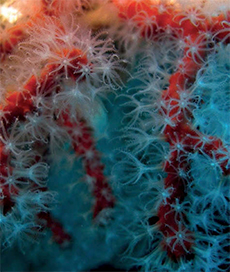




| Home | Features | Club Nights | Underwater Pics | Feedback | Non-Celebrity Diver | Events | 8 August 2025 |
| Blog | Archive | Medical FAQs | Competitions | Travel Offers | The Crew | Contact Us | MDC | LDC |

|

|
 
 |
 ISSUE 19 ARCHIVE - RED CORAL JEWELLERYRed coral or precious coral (Corallium Rubrum) has been the subject of long debate between the jewellery making industry and environmental agencies. It is an issue that keeps comingback with the United States and the European Union representatives at CITES trying to list red coral on the protected species appendix II but then the regulations were yet again turned down by governments in 2010. So what are the arguments on each side of the debate? Red and pink coral are the most valuable of all corals, they are living marine mammals consisting of red skeleton and white polyps. They grow very slowly and it takes many years for corals to reach reproductive age and when they reproduce, few young survive. Red corals have been fished and traded for centuries for medical properties but mainly for jewellery, fashion and decoration accessorises using the red skeleton to produce various pieces from necklaces to lamps and vases. The most expensive and valuable are the Mediterranean corals and the red coral from Japan. Nowadays consumer demands for the precious coral have depleted the reproductive line of by over 70% since the 1980s. The red coral industry is worth millions of dollars each year and most of it is harvested in Italy, Japan and Taiwan. This is quite alarming especially knowing the methods of harvesting the corals which have completely destroyed the population of precious coral above 50 metres. Dredging (huge nets dragged on the ocean floor), which destroys everything in its path has now been replaced by specialised technical scuba diving or submarines to fish the precious corals at depth. It seems that again,man is biting the hands that feeds it. European Union countries have their own regulations, quotas, permits, licences, protected zones to preserve their corals but it is still not enough to stop the bleeding in jewellers' windows on the Bay 39 of Naples and the surrounding areas. The irony is that the demand for red coral is so big from consumers in Europe that most of the precious coral is now imported from Asia due to the complete depletion of corals in the Med. (The US are the biggest importers of precious corals jewellery and ornaments.) Jewellers like Tiffany's and Co are now in favour of placing the red corals on the appendix II of protected species realising that it is the only way to preserve the "pray-cious". Some are going for farmed corals (bred in aquariums not affecting the reef) which is a way forward if you are that desperate but deep precious corals cannot be farmed (obviously... unless you have a very deep aquarium!). Really once the frenzy for mad consumerism of the precious corals refrains, the harvesting will slow down. Jewellery designer, Claudia Crescenzo Mariniello, from Temple St Clair said: "It's now up to the jewellery and design industry to stop buying and using this coral so populations can recover. If consumer demand is lessened, perhaps governments and the coral industry will get serious about protecting these precious animals for future generations." Let's follow the Sea Web campaign slogan "Too precious to wear" and don't buy it if you don't need it. For more info: Seaweb |